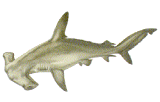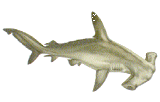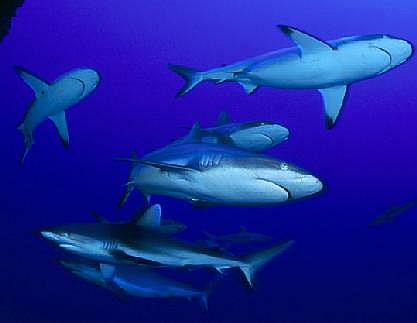SHARKS

SHARKS
Of Hawai`i
"Ka Mano o Hawai`i"

|
Sharks in Hawaiian Waters . . .![[SHARKS . . . of Hawai`i]](http://www.loststory.net/sites/default/files/nature_page/sharkint.jpg)
About eight species are commonly seen near shore. The most frequently encountered are the Sandbar, Reef Whitetip, Scalloped Hammerhead, and occasionally Tiger. These inshore species are Sharks have As sharks approach their prey, they can detect the faint electrical fields give off by all living organisms. Receptors on their snouts, known as ampullae of Lorenzini, allow sharks to locate their prey without seeing it. Using these senses, sharks can find prey at dusk, night and dawn, which is when inshore species are generally believed to feed. Sharks are very well aware of their environment and appear to be fairly curious by nature. They are aware of people in the water before people are aware of them. Encounters between sharks and people are infrequent, and While A Tiger shark is easily recognized by its blunt snout and the vertical bars on its sides. A Galapagos shark is harder to identify; however, any large (over six feet) gray shark with no conspicuous markings seen in inshore waters is probably a Galapagos.
Tigers seem to come into inshore waters in Fall, and stay through Spring. They appear to move offshore somewhat in Summer, but this remains to be confirmed. Like other inshore species, Tigers seem to feed mostly during night and twilight hours. Tigers are often attracted to stream mouths after heavy rains, when upland fishes and other animals are swept out to sea. They can easily locate prey in such murky waters. Tigers are also attracted to waters frequented by fishing boats, which often trail fish remains and blood. Of all the inshore species, Tigers have the most widely varied diet. They eat fish, lobsters, birds, turtles, dead animals, even garbage. It's not known how long Tigers can go without eating, but they soon seem to feed whenever a food source is present. It's also not known why Tigers sometimes attack humans. A Tiger may mistake a person for a prey item, it may come across a person while in a feeding "mode," Divers who may encounter sharks often carry a shark billy or a bang stick. A billy is a club used to fend off a shark by hitting it on the snout. A bang stick is a rod with an explosive charge at the tip, used to kill an aggressive shark. Bang sticks are effective, but very dangerous. In addition, the resulting blood may attract other sharks.
People who enter the water need to recognize that  Source: The Division of Aquatic Resources, Department of Land and Natural Resources, State of Hawai`i Source: The Division of Aquatic Resources, Department of Land and Natural Resources, State of Hawai`i |
 |
~ Suggested Readings on Sharks ~
Books for Young Readers:
- Barrett, Norman. Picture Library: Sharks. Danbury, Connecticut: Franklin Watts (Grolier Publishing), 1989.
- Cole, Joanna. Hungry, Hungry Sharks. New York: Random House, 1986.
- Markle, Sandra. Outside and Inside Sharks. New York: Atheneum Books for Young Readers (Simon & Schuster), 1996.
- Prevost, John. Great White Sharks. Edina, Minnesota: ABDO & Daughters, 1996.
- Simon, Seymour. Sharks. New York: Harper Collins Publishers, 1995.
- Walker, Jane. Fascinating Facts About Sharks . Brookfield, Connecticut: The Millbrook Press, 1993.
Books for Older Readers:
- Batten, Mary. Shark Attack Almanac (KidBacks) . New York: Random House, 1997.
- Budker, Paul. The Life of Sharks. New York: Columbia University Press, 1971.
- Bunting, Anne Eve. The Sea World Book of Sharks. San Diego: Sea World Press, 1979.
- Castro, José I. The Sharks of North American Waters. College Station, Texas: Texas A & M University Press, 1983.
- Cerullo, Mary. Sharks: Challengers of the Deep. New York: Cobblehill Books/Dutton, 1993.
- Chovan, Judith L. and Sara E. Crump. Sharks: Fact and Fantasy. Los Angeles: Natural History Museum of Los Angeles County, Education Division, 1990.
- Compagno, Leonard J.V. FAO Species Catalogue, Vol. 4. An Annotated and Illustrated Catalogue of Shark Species Known to Date. Rome: FAO, 1984.
- Compagno, Leonard J.V. Sharks of the Order Carcharhiniformes. Princeton, New Jersey: Princeton University Press, 1988.
- Crockett, Jim. The Great White Shark. New York: Arch Cape Press, 1989.
- Ellis, Richard and John E. McCosker. Great White Shark. New York: Harper Collins, 1991.
- Cousteau, Jacques-Yves and Philippe Cousteau. The Shark: Splendid Savage of the Sea. New York: Doubleday & Company, Inc., 1970.
- Cousteau, Jean-Michel and Mose Richards. Great White Shark. New York: Harry N. Abrams, Inc., 1992.
- Dingerkus, Guido. The Shark Watchers' Guide. New York: Julian Messner, 1985.
- Ellis, Richard and John E. McCosker. Great White Shark. New York: Harper Collins, 1991.
- Ferguson, Ava and Gregor Cailliet. Sharks and Rays of the Pacific Coast. Monterey, California: Monterey Bay Aquarium, 1990.
- Gruber, Samuel H., ed. Discovering Sharks. Highlands, New Jersey: American Littoral Society, 1991.
- Hall, Howard. Sharks. San Luis Obispo, California: Blake Publishing, 1990.
- Hall, Howard. Sharks: The Perfect Predators. New York: Silver Burdett Press (at Simon & Schuster Co.), 1995.
- MacQuitty, Miranda. Eyewitness Books: Sharks . New York: Dorling Kindersley (Alfred F. Knopf), 1992.
- Matthews, Rupert. How They Live. Sharks. New York: Mallard Press, 1989.
- Moss, Sanford A. Sharks, an Introduction for the Amateur Naturalist. Englewood Cliffs, New Jersey: Prentice Hall, Inc., 1984.
- Reader's Digest Services. Sharks, Silent Hunters of the Deep. New York: Reader's Digest, 1986.
- Sattler, Helen. Sharks, the Super Fish. New York: Lothrop, Lee & Shepard Books, 1986.
- Server, Lee. Sharks. New York: Crescent Books, 1989.
- Springer, Victor G. and Joy P. Gold. Sharks in Question. The Smithsonian Answer Book. Washington, D.C.: Smithsonian Institution Press, 1989.
- Stafford-Deitsch, Jeremy. Shark. A Photographer's Story. San Francisco: Sierra Club Books, 1988.
- Steel, Rodney. Sharks of the World. New York: Facts on File, Inc., 1985.
- Stevens, John D., ed. Sharks. New York: Facts on File, Inc., 1987.
- Suzumoto, Arnold. Sharks Hawaii. Honolulu: Bishop Museum Press, 1991.
- Taylor, Leighton. Sharks of Hawai'i: Their Biology and Cultural Significance. Honolulu: University of Hawaii Press, 1993.
- Walker, Niki and Kalman, Bobbie. Sharks. New York: Crabtree Publishing Group, 1997.
- Wheeler, Alwyne. Sharks. New York: Gloucester Press, 1987.
Here's a link to a very comprehensive, annotated bibliography online, References on Sharks by the National Museum of Natural History in its Encyclopedia Smithsonian. (However, it hasn't been updated since 1995.)
